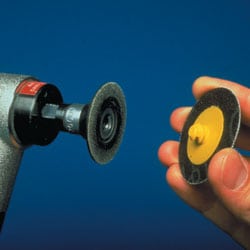In the old days Dremel sanding disks attached to a shaft using a central screw. The head of this screw prevented use of the central part of the disk. Later they switched to the EZ-lock system (shown on left in the photo) which attaches from the back and makes the whole disk available for use.
The 1.25" diameter of the EZ-lock disks was a bit too large for me and so I made a 1" diameter disk (shown in the middle). When I bought Dremel's new 2050 model even the 1" disk seemed oversized so I made a 0.75" disk (shown on right).
Today I ran into a sanding task that required something even smaller. Rather than turn a new disk, I took the easy way out. I found a nail with a diameter close enough to 0.125" to be grasped in the Dremel collet. Stuck some self-stick sand paper to the head and trimmed away the excess and now I've got a 0.3" sanding disk. Obviously only for very fine work but it worked well in my application.
A few words about the Dremel 2050 (no, I don't work for them)...
It's difficult, if not impossible to comfortably hold most Dremels the way you would hold a pencil. It's exactly this hold that provides the best fine motor control for work like lettering. Even my Foredom doesn't do what I want because of the drag of the flexible shaft that drives it.
Dremel has long sold a pencil-like tool, the Micro, but it's bulkier because of the onboard batteries and then there's the battery life concern.
What one wants is a tool mains-powered via an offboard voltage converter housed in the mains plug and connected to the tool via a thin, highly flexible cord. And that's exactly what the 2050 is.
It's low-powered; you won't want to grind your welds or cut 1/4" steel with a grinding disk with it. But it's a real pleasure to use for fine work.
https://www.amazon.com/Dremel-2050-1...gateway&sr=8-1



 LinkBack URL
LinkBack URL About LinkBacks
About LinkBacks



 Reply With Quote
Reply With Quote





Bookmarks